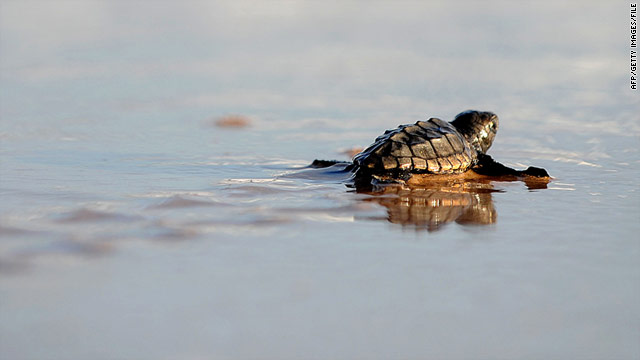U.S. beefs up conservation efforts for endangered sea turtles

- Loggerheads to be divided into 9 groups, according to location
- Their threats vary by geography, experts say
- More than 4,500 are killed every year by commercial fishing
(CNN) -- The government has revised its rules on sea turtles to try to decrease the number killed every year and reduce the threats they face.
The new regulations place the Loggerhead turtle into nine distinct population groups, depending on where they live, instead of listing the marine animal as a single worldwide species. In all nine segments the turtles are listed as either threatened or endangered.
Officials at both the National Oceanic and Atmospheric Administration and the U.S. Fish and Wildlife Service, both responsible for overseeing the turtle conservation efforts, say they can better address the challenges the turtles face with the new geographical division.
Loggerhead or marine turtles live in tropical and subtropical waters around the world. The new "distinct population segments" for the turtles are: The Northeast Atlantic Ocean group, the Mediterranean Sea, the North Indian Ocean, the North Pacific Ocean, the South Pacific Ocean, the Northwest Atlantic, which includes the Gulf of Mexico and our Atlantic Coast, the South Atlantic Ocean, the Southeast Indo-Pacific Ocean and the Southwest Indian Ocean.
Researchers estimate more than 4,500 loggerheads are killed every year by commercial fishing, but environmentalists believe the number is probably much higher.
Commercial fishing is one of the biggest risks for the turtles, whether they live in the Indian, Pacific or Atlantic oceans, said Jim Lecky, the fisheries director for the National Oceanic and Atmospheric Administration.
"They all continue to be challenged by a number of threats, incidental capture in fishing gear, longlines, gill nets, trawl gear, trap and pot lines, which tangle turtles and other species, and dredges; all have incidental mortality of sea turtles in those fisheries," he said.
But Lecky says that's not the only threat for the turtles. "They are all also challenged by losses of habitat, degradation of nesting habitat. There still is direct harvest of eggs in adults ... at some level and they are all subject to vessel strikes."
The turtles are facing all those threats, but at different levels. So the new rules will allow fine-tuning of sea turtle conservation measures and regulations.
"We believe that this revised listing of the Loggerhead will help us and our partners to better focus recovery and conservation efforts by allowing us to take a more regional approach. But, again, the separation of Loggerhead into these population groups will not reduce our current conservation efforts," said Sandy MacPherson, the national sea turtle coordinator for the U.S. Fish and Wildlife Service.
MacPherson also told CNN Radio, "These new listings will help us to provide more focused recovery and conservation, as well as more focused threat analysis and evaluation of conservation successes."
The Center for Biological Diversity said in a statement that Loggerhead populations "need more protection to survive this century."
The rule revisions also included designating five regional populations as endangered species, which the group characterized as "a wake-up call that a whole host of threats, from oil spills, channel dredging and commercial trawling to longline and gillnet fisheries, continue to kill off turtles faster than the animals can possibly hope to reproduce."
CNN's Ninette Sosa and Barbara Hall both contributed to this report.
